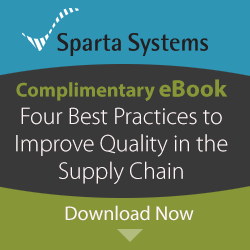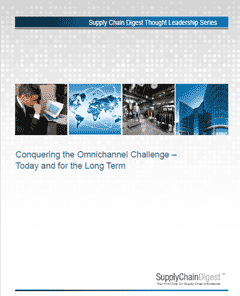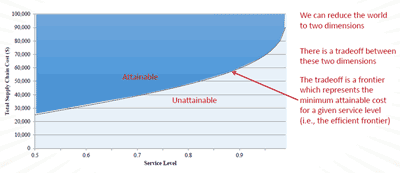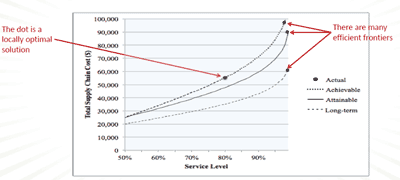 |
September 18, 2015 - Supply Chain Flagship Newsletter |
 |
| FEATURED SPONSOR: SPARTA SYSTEMS |
||
 |
||
Download Complimentary eBook: |
 |
|
||||||||||||||||||||||||||||||||||||||||||||||||||||||||||||||||||||||||||||||
Ditto with transportation costs versus inventory levels, or more fundamentally supply chain cost versus service. There are others (e.g., manufacturing agility versus cost). But after seeing these classic tradeoff curves in college, as a core concept in supply chain theory, do we ever see or use them again? Not much if at all, in my experience. So pondering this just this past July, I emailed Dr. Michael Watson of Northwestern University and his new firm OpEx Analytics. Watkins is also a regular SCDigest contributing columnist and a true world class analytics expert. My question: are tradeoff curves real?
So we agreed this was a topic worth exploring in more detail, though we haven't returned back to it in the intervening weeks. So this week I am at the excellent Logility software Connections user conference in San Diego, and run into Dr. Sean Willems, who is simply one of the sharpest minds we have today in supply chain. Willems co-founded inventory optimization company Optiant, which Logility acquired a few years ago. He remains Logility's chief scientist, and just recently left his alma mater MIT to take the position as the Haslem chair of supply chain analytics at the University of Tennessee. Let's just say his credentials are pretty solid.
"Tradeoff curves," he tells me. My supply chain spider sense is tingling a bit. It turns out.Willems has been thinking hard about tradeoff curves for the last few years. His presentation, which I will do my best to summarize here, was outstanding. I will start by noting that Willems likes to use the concept of supply chain "efficiency frontiers" in place of tradeoff curves, which I will explain in just a bit. He used the graphic below to illustrate how this concept is usually presented, using the supply chain cost versus customer service tradeoff. |
|||||||||||||||||||||||||||||||||||||||||||||||||||||||||||||||||||||||||||||||
That is why Willems uses the term "efficient frontier" - the curve represents the border line between the attainable (lowest cost for a given service level) and the unattainable (again given current resources). And he adds that even getting to that efficiency curve from where a company is really operating today is generally not easy. "If it was, we'd just do it," Willems noted. He gave another example. Is there a tradeoff between the "cadence" of supply chain planning and supply chain costs? Now that is an interesting question. In other words, if a company moved from monthly S&OP to say weekly S&OP, would that deliver lower supply chain costs? It might, Willems said, as there would be less latency of information between planning cycles. But maybe it's the opposite. The planning might actually become less efficient by trying to do it so frequently, and maybe costs would actually increase with a faster cadence. Willems then made the key point - a given company has no idea what lies to the left or right (faster or slower cadence) of using a monthly planning cycle. And circling around, this fact is in large measure why I ask Watkins if supply chain curves are real back in July. My mind was in the same place as Willems described this scenario in San Diego. You are on a tradeoff curve, but don't know what it is. I am not sure if this is a generality or for some specific company, but Willems then showed a chart that indicated the optimal planning cadence was actually about 22 days - let's say three weeks - rather than a month. But again, for most companies, making this change from monthly to thrice weekly S&OP cycles would take a major effort and process change, and would obviously not be without risk. So the key point is that it is generally hard not only to get to the true curve itself from where your current dot is really at in the attainable region, as discussed above, but also even to move along the curve once you are there. Now let's get back to the efficient frontier. There isn't one curve, Willems says, but several - and this gets to the point of not moving along the curve, but fundamentally shifting it. Not trading off between say costs and service, but improving both at the same time. That is shown in the image below. A small shift from the current efficient frontier Willems calls the "attainable" - what a company can achieve in immediate term, with small changes to resources, operating policies and better use of technology.
|
|||||||||||||||||||||||||||||||||||||||||||||||||||||||||||||||||||||||||||||||
I am out of space, but am very excited about where this can go, both from Willems' own research and some things we are going to do in SCDigest, now re-energized on this topic. Maybe some collaboration between several of us. But I will sum it up like this: being a curve shifter is simply what supply chain excellence - and generally supply chain transformation efforts - is all about. More soon. Any reaction to this discussion of supply chain tradeoff curves and the efficient frontier? What can you add to the discussion? Let us know your thoughts at the Feedback button below. |
|||||||||||||||||||||||||||||||||||||||||||||||||||||||||||||||||||||||||||||||
|
|||||||||||||||||||||||||||||||||||||||||||||||||||||||||||||||||||||||||||||||
|
|||||||||||||||||||||||||||||||||||||||||||||||||||||||||||||||||||||||||||||||
|
|
|
YOUR FEEDBACK
Catching up on some miscellaneous Feedback this week - we're behind.
Feedback on SCDigest Omnichannel Report:
I just read your white paper "Conquering the Omnichannel Challenge - Today and for the Long Term." Eric Lambert Editor's Note: |
||
| Feedback on SCDigest Q2 Rail Review: | ||
Do you have BNSF numbers? Editor's Note: |
||
| Recent Feedback on We're Not Sure What but They are Pretty Good: | ||
In my opinion, supply chain managers are crucial for the world economy. They represent a single discipline, responsible for supporting the global network of delivery of products and services throughout the supply chain, from raw materials to delivery of products and services to end customers. Specifically, administrators/managers supply chain are committed to the design, planning, execution, control, and monitoring of activities in the supply chain with the objective of generating added value, building a competitive infrastructure . In any business, the supply chain depends on the knowledge we have on raw materials, planning, manufacturing, distribution, etc. Likewise, the development of new products requires knowledge of the needs of consumers, new scientific discoveries, new technologies, marketing, etc. The challenge of applying knowledge in a company to create competitive advantage becomes even more challenging because the market is increasingly competitive, which demand greater product innovation. Because of this, knowledge must be developed and assimilated increasingly faster.
Mela Moskera |
||
Demand chain management (DCM) is the management of relationships between suppliers and customers to deliver the best value to the customer at the least cost to the demand chain as a whole. Demand chain management is similar to supply chain management but with special regard to the customers. |
SUPPLY CHAIN TRIVIA ANSWER
Q: What percent of revenue does the average large company spend on its procurement organization (people, technology, etc.)?
A: Just 0.8%, according to a new study from Accenture, down from 1% in 2007, as the discipline continues to get more efficient.
| © SupplyChainDigest™ 2003-2015. All Rights Reserved. SupplyChainDigest PO Box 714 Springboro, Ohio 45066 |
POWERED BY: XDIMENSION
|







 And this, Willems said, is where analytics can play a key role. Analytics can create that curve of tradeoffs between the planning cadence and supply chain costs (or numerous others), calculating for example where and if more frequent planning would have improved decision making that lowered costs - or the opposite.
And this, Willems said, is where analytics can play a key role. Analytics can create that curve of tradeoffs between the planning cadence and supply chain costs (or numerous others), calculating for example where and if more frequent planning would have improved decision making that lowered costs - or the opposite.


